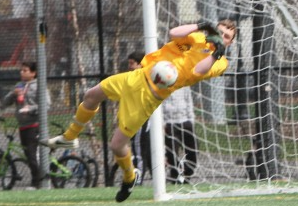The goalkeeper needs to assess many things when the ball is played through and into the box. Often it is behind the defense so communication is needed, but off the top of my head these other factors come into play.
1. Condition of field ( greasy or dry )
2. Speed of opposition and your own players
Here are some scenarios that make sense of some decision making.
65% – 35% in favor of the goalkeeper.
Easiest save to make is the scooped pick up. Lead foot must be next to the ball. Ensure you lead with your shoulder, have both hands behind the ball ( ready to scoop the ball up ). Bring the ball in and be ready to distribute early.
http://http://youtu.be/jcgjBXffujo
60% – 40% in favor of the goalkeeper.
The dive at feet technique. First contact is hands to ball, ensure a low trajectory of dive by bending nearest knee and make sure you are not too close to the ball when you dive.
Hands should be one behind and one on top of the ball. Complete the save by bringing the ball in, tucking your head in and bringing your top knee up to protect any vulnerable areas.
https://www.youtube.com/watch?v=3GGUqgEoSdY&feature=youtu.be
https://www.youtube.com/watch?v=86bl8c6e9II
50% – 50% saves.
This is when the goalkeeper makes contact with the ball the same time as the opposing player gets a foot to the ball.
Goalkeeper’s hand shapes change to create a claw with arms straight for stability. Wrists should be locked too. The claw is to ensure both hands are behind the ball and that with contact the loose ball rolls down the goalkeepers body to safety.
40% – 60% in favor of the opposition.
Brave goalkeepers should still be coming for these balls with the belief that they can get there. Don’t forget the goalkeeper should be one of the fastest players on the team. If the goalkeeper does not quite get there in time, he or she will be required to make a point blank save. This is where the ball hits the goalkeeper at close range. This point blank save may be made with the goalkeeper committed to the dive, with the goalkeeper in the gate position or even in a starfish position. All methods should be with the aim of making yourself big and blocking the path of the ball.
https://www.youtube.com/watch?v=mZvFR7-CqAU
35% – 65% in favor of the opposition.
This is where you have probably made the wrong choice to come to the ball and are committed. The gate position has to be applied with the aim of delaying the opponent until a defender can get back. The first defender’s job may be to cover you in goal.
The five S’s of defending can be applied here.
1 – Shut down
2 – Slow down
3 – Sit down ( into the gate position )
4 – Stay down and wait for the mistake
5 – Steal the ball

















